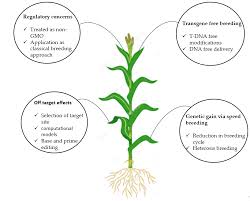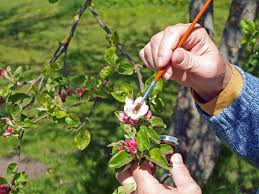Modern plant breeding, whether classical or through genetic engineering, comes with issues of concern, particularly with regard to food crops.
The question of whether breeding can have a negative effect on nutritional value is central in this respect.
Although relatively little direct research in this area has been done, there are scientific indications that, by favoring certain aspects of a plant’s development, other aspects may be retarded.
A study published in the Journal of the American Collegeof Nutrition in 2004, entitled Changes in USDA Food Composition Data for 43Garden Crops, 1950 to 1999, compared nutritional analysis of vegetables done in 1950 and in 1999, and found substantial decreases in six of 13 nutrients measured, including 6% of protein and 38% of riboflavin.
Reductions in calcium, phosphorus, iron and ascorbic acid were also found. The study, conducted at the Biochemical Institute, University of Texas at Austin, concluded in summary:
“We suggest that any real declines are generally most easily explained by changes in cultivated varieties between 1950 and 1999, in which there maybe trade-offs between yield and nutrient content.”

The debate surrounding genetically modified food during the 1990s peaked in early 2000 in terms of media coverage and risk perception, and continues today – for example,
“Germany has thrown its weight behind a growing European mutiny over genetically modified crops by banning the planting of a widely grown pest-resistant corn variety”.
The debate encompasses the ecological impact of genetically modified plants, the safety of genetically modified food and concepts used for safety evaluation like substantial equivalence.
Such concerns are not new to plant breeding. Most countries have regulatory processes in place to help ensure that new crop varieties entering the marketplace are both safe and meet farmers’ needs. Examples include variety registration, seed schemes, regulatory authorizations for GM plants, etc.
Plant breeders’ rights are also a major and controversial issue. Today, production of new varieties is dominated by commercial plant breeders, who seek to protect their work and collect royalties through national and international agreements based in intellectual property rights.
The range of related issues is complex. In the simplest terms, critics of the increasingly restrictive regulations argue that, through a combination of technical and economic pressures, commercial breeders are reducing biodiversity and significantly constraining individuals (such as farmers) from developing and trading seed on a regional level.
Efforts to strengthen breeders’ rights, for example, by lengthening periods of variety protection, are on-going.
When new plant breeds or cultivars are bred, they must be maintained and propagated. Some plants are propagated by asexual means while others are propagated by seeds.
Seed propagated cultivars require specific control over seed source and production procedures to maintain the integrity of the plant breeds results.
Isolation is necessary to prevent cross contamination with related plants or the mixing of seeds after harvesting.
Isolation is normally accomplished by planting distance but in certain crops, plants are enclosed in greenhouses or cages (most commonly used when producing F1 hybrids.)
Read Also : Cytological principles of plant breeding
Steps of Plant Breeding

The following are the major activities of plant breeding; Creation of variation, Selection, Evaluation, Release Multiplication, Distribution of the new variety.
Participatory Plant Breeding
The development of agricultural science, with phenomenon like the Green Revolution arising, have left millions of farmers in developing countries, most of whom operate small farms under unstable and difficult growing conditions, in a precarious situation.
The adoption of new plant varieties by this group has been hampered by the constraints of poverty and the international policies promoting an industrialized model of agriculture.
Their response has been the creation of a novel and promising set of research methods collectively known as participatory plant breeding.
Participatory means that farmers are more involved in the breeding process and breeding goals are defined by farmers instead of international seed companies with their large-scale breeding programs.
Read Also : The Top Global Trends Driving the Fourth Agricultural Revolution
Farmers’ groups and NGOs, for example, may wish to affirm local people’s rights over genetic resources produce seeds themselves, build farmers’ technical expertise, or develop new products for niche markets, like organically grown food.
In summary, plant breeding ensure food security by developing new varieties that are higher-yielding, resistant to pests and diseases,
Drought-resistant or regionally adapted to different environments and growing conditions can be established through
With plant breeding crops uniformity in maturity time and other desirable qualities can be selected. Plant breeding in certain situations may lead to the domestication of wild plants.
Plant breeding can increased quality and yield of the crops through the following:
Increased tolerance of environmental pressures (salinity, extreme temperature, and drought); Resistance to viruses, fungi and bacteria; Increased tolerance to insect pests; and Increased tolerance of herbicides.
Read Also : Hazardous Substances and Plant Growth





